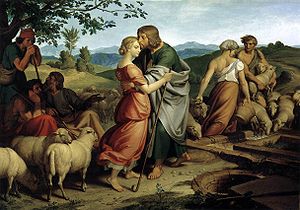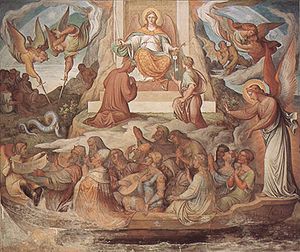- Nazarene movement
-
For other uses, see Nazarene (disambiguation).
 In Jacob encountering Rachel with her father's herd, Joseph von Führich attempts to recapture the mood of Perugino and Raphael, 1836 (Österreichische Galerie, Vienna)
In Jacob encountering Rachel with her father's herd, Joseph von Führich attempts to recapture the mood of Perugino and Raphael, 1836 (Österreichische Galerie, Vienna)
The name Nazarene was adopted by a group of early 19th century German Romantic painters who aimed to revive honesty and spirituality in Christian art. The name Nazarene came from a term of derision used against them for their affectation of a biblical manner of clothing and hair style.
Contents
History
In 1809, six students at the Vienna Academy formed an artistic cooperative in Vienna called the Brotherhood of St. Luke or Lukasbund, following a common name for medieval guilds of painters. In 1810 four of them, Johann Friedrich Overbeck, Franz Pforr, Ludwig Vogel and Johann Konrad Hottinger moved to Rome, where they occupied the abandoned monastery of San Isidoro. They were joined by Philipp Veit, Peter von Cornelius, Julius Schnorr von Carolsfeld, Friedrich Wilhelm Schadow and a loose grouping of other German artists. They met up with Austrian romantic landscape artist Joseph Anton Koch (1768–1839) who became an unofficial tutor to the group. In 1827 they were joined by Joseph von Führich (1800–1876) (illustration above right).
The principal motivation of the Nazarenes was a reaction against Neoclassicism and the routine art education of the academy system. They hoped to return to art which embodied spiritual values, and sought inspiration in artists of the late Middle Ages and early Renaissance, rejecting what they saw as the superficial virtuosity of later art.
In Rome the group lived a semi-monastic existence, as a way of re-creating the nature of the medieval artist's workshop. Religious subjects dominated their output, and two major commissions allowed them to attempt a revival of the medieval art of fresco painting. Two fresco series were completed in Rome for the Casa Bartholdy (1816–17) (moved to the Alte Nationalgalerie in Berlin) and the Casino Massimo (1817–29), and gained international attention for the work of the 'Nazarener'. However, by 1830 all except Overbeck had returned to Germany and the group had disbanded. Many Nazareners became influential teachers in German art academies.
Legacy
The artistic achievement of the Nazarenes is difficult to evaluate; their finished paintings appear less impressive with the perspective of history than they did to their contemporaries. Awkward composition, weak colouring and derivative themes detract from the challenge of their work in its time. However, the programme of the Nazarenes—the adoption of honest expression in art and the inspiration of artists before Raphael—was to exert considerable influence in Germany, and in England upon the Pre-Raphaelite movement. In their abandonment of the academy and their rejection of much official and salon art, the Nazarenes can be seen as partaking in the same anti-scholastic impulse that would lead to the avant-garde in the later nineteenth century.
Notable members
- Peter von Cornelius
- Josef Führich
- Johann Konrad Hottinger
- Johann Friedrich Overbeck
- Franz Pforr
- Friedrich Wilhelm Schadow
- Julius Schnorr von Karolsfeld
- Eduard Jakob von Steinle
- Philipp Veit
- Johannes Veit
- Ludwig Vogel
- Eugene Von Guerard
Painters
 Joseph Anton Koch, Detail des Dante-Zyklus in der Casa Massimo
Joseph Anton Koch, Detail des Dante-Zyklus in der Casa Massimo
- Carl Joseph Begas
- Peter von Cornelius
- Ernst Deger
- Konrad Eberhard
- Carl Eggers
- Marie Ellenrieder
- Gebhard Flatz
- Joseph von Führich
- Josef von Hempel
- Franz Ittenbach
- Gustav Jäger
- Johannes Kaspar
- Leopold Kupelwieser
- Friedrich Lange
- Ferdinand Olivier
- Friedrich Olivier
- Johann Friedrich Overbeck
- Johann David Passavant
- Carl Gottlieb Peschel
- Franz Pforr
- Johann Anton Ramboux
- Theodor Rehbenitz
- Wilhelm von Schadow
- Johann Scheffer von Leonhartshof
- Julius Schnorr von Carolsfeld
- Ludwig Schnorr von Carolsfeld
- Johann von Schraudolph
- Claudius Schraudolph der Ältere
- Joseph Anton Nikolaus Settegast
- Eduard von Steinle
- Philipp Veit
- Johannes Veit
- Josef Wintergerst
- Johann Michael Wittmer
See also
Further reading
- Mitchell Benjamin Frank. Romantic Painting Redefined: Nazarene Tradition and the Narratives of Romanticism. Ashgate Publishing, 2001; ISBN 0-7546-0477-2
- Lionel Gossman. “Making of a Romantic Icon: The Religious Context of Friedrich Overbeck’s ‘Italia und Germania.’” American Philosophical Society, 2007. ISBN 0871699753. [1]
- Lionel Gossman. "Unwilling Moderns: The Nazarene Painters of the Nineteenth Century" in Nineenth-Century Art Worldwide - Volume 2, Issue 3, Autumn 2003 [2]
Art movements 5th to 18th century Merovingian · Carolingian · Ottonian · Romanesque · International Gothic · Renaissance (14th-15th) · Mannerism (16th) · Caravaggisti (16th) · Baroque - Classicism (17th) · Rococo - Neoclassicism - Romanticism (18th)19th century Nazarene · Realism · Historicism · Biedermeier · Gründerzeit · Barbizon school · Pre-Raphaelites · Academic · Impressionism · Post-Impressionism · Neo-impressionism · Divisionism · Pointillism · Cloisonnism · Les Nabis · Synthetism · Symbolism · Hudson River School20th century Cubism · Orphism · Purism · Synchromism · Expressionism · Scuola Romana · Abstract expressionism · Kinetic art · Neue Künstlervereinigung München · Der Blaue Reiter · Die Brücke · New Objectivity · Dada · Fauvism · Neo-Fauvism · Precisionism · Art Nouveau · Bauhaus · De Stijl · Art Deco · Op art · Vienna School of Fantastic Realism · Pop art · Photorealism · Futurism · Metaphysical art · Rayonism · Vorticism · Suprematism · Surrealism · Color Field · Minimalism · Nouveau réalisme · Social realism · Lyrical Abstraction · Tachisme · COBRA · Action painting · International Typographic Style · Fluxus · Lettrism · Letterist International · Situationist International · Conceptual art · Installation art · Land art · Performance art · Systems art · Video art · Neo-expressionism · Neo-Dada · Outsider art · Lowbrow · New media art · Young British Artists21st century Hyperrealism · Intervention art · Stuckism International · Remodernism · IMMAGINE&POESIA · Pseudorealism · Sound art · Superstroke · Superflat · SoFlo Superflat · Relational art · Video game art · Energy ArtRelated articles Categories:
Wikimedia Foundation. 2010.
